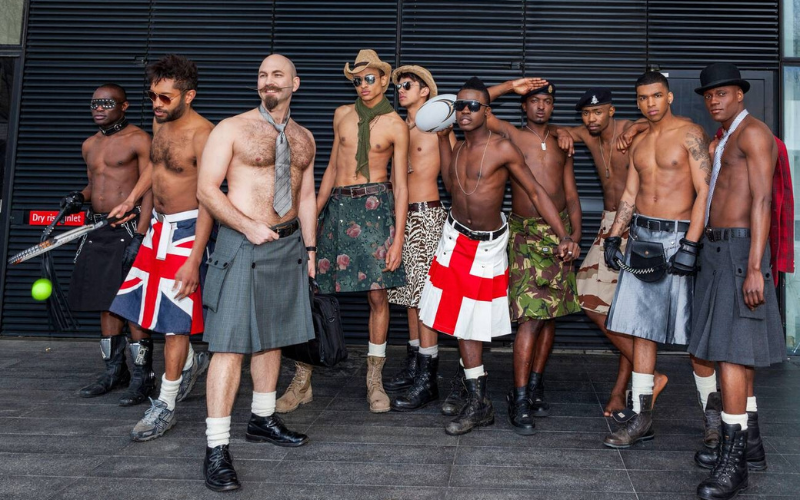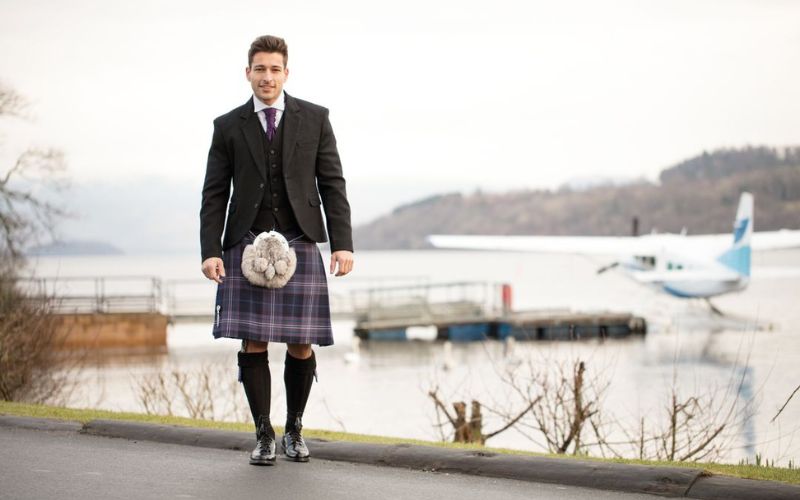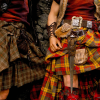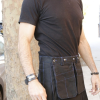When one thinks of kilts, Scotland often comes to mind. However, the Irish also have a special connection to this iconic garment. The Irish kilt, known as the “Lein-croich,” has a fascinating history that stretches back centuries. While kilts may be more widely associated with Scotland, the Irish kilt boasts its own distinct charm and cultural significance. In this comprehensive article, we will delve into the evolution of the Irish kilt, exploring its origins, symbolism, and the pioneers who brought it to Ireland. Join us on this journey as we celebrate the rich heritage and allure of the Irish kilt.

The Origins of the Irish Kilt
The history of the Irish kilt can be traced back to the 11th century when the distinctive “Lein-croich” emerged as a unique Irish garment. Unlike the Scottish kilt, the Lein-croich was akin to a bundled-up blanket draped over the body. Paintings from that era capture the intriguing aspect of Irish fashion, depicting individuals who wore nothing underneath this garment. While kilts are traditionally associated with Scotland, the Irish kilt holds its own place in Celtic tradition, showcasing the uniqueness of Irish culture.
The Pioneers of Kilt
In the early 20th century, around 1910, Irish students and faculty at a school became pioneers in bringing kilts to Ireland. Each of Ireland’s provinces – Ulster, Connacht, Leinster, and Munster – developed their own distinct tartan designs. This marked a significant turning point in the adoption of kilts in Ireland, as they became emblematic of Gaelic heritage. Scottish kilts, with their rich history dating back to the 1500s, influenced the style and appearance of the Irish kilt.The traditional color for Irish kilts is saffron, a deep yellow shade often embellished with shamrocks, symbolizing Irish pride.
The Irish Kilt: Style and Appearance
The Irish kilt, much like its Scottish counterpart, is characterized by its pleated design and use of tartan patterns. However, there are notable differences between the two. While Scottish kilts feature a wide variety of plaids, Irish kilts typically showcase solid colors or simpler patterns. Irish kilts are more commonly worn for special occasions rather than as everyday attire, adding to their sense of elegance and significance. The Irish kilt has become a symbol of Irish identity, representing a connection to heritage and cultural pride.
Irish Kilt Accessories: Completing the Ensemble
To complete the traditional Irish kilt outfit, various accessories are essential. The Irish sporran, a functional pouch worn at the front of the kilt, adds both practicality and style. Unlike Scottish kilts that often display clan crests, Irish kilts commonly feature shamrock crests or are left unadorned for a more minimalist look. For formal occasions, the Brian Boru Jacket or Kilkenny Jacket can be paired with a standard collared shirt, a waistcoat, and a bowtie. Kilt hose, traditionally in cream color with tartan-coordinating ribbons, and Ghillie Brogues, leather shoes with long ties, complete the ensemble, adding a touch of authenticity to the Irish kilt outfit.
Exploring Irish Tartans: Symbolism and Significance
Tartans play a significant role in the Irish kilt, symbolizing deep clan affiliations and ancestral roots. While Scotland boasts numerous family tartans, Ireland has a more limited selection. Certain Irish surnames, such as Murphy, O’Neil, and Fitzpatrick, have registered tartans associated with them. Additionally, Irish counties and provinces are represented by their distinctive tartans, reflecting the wearer’s ancestral connections. These tartans not only add a vibrant touch to the Irish kilt but also carry historical significance, representing the timeless pride and traditions of Ireland.
Irish Kilts: From Ancient Times to Modern Celebrations
Throughout history, Irish kilts have held a special place in various celebrations and gatherings. They were worn during political events, music festivals, and weddings, marking moments of cultural significance. Notably, Irish patriot Patrick Pierce played a significant role in popularizing kilts by adopting them as uniforms for dance students. Today, Irish kilts continue to be cherished garments, often seen at weddings, cultural festivals, and formal events. They serve not only as fashion statements but also as a testament to the enduring traditions and rich cultural heritage of Ireland.
Irish Kilts vs. Scottish Kilts: Unraveling the Distinctions
While Irish and Scottish kilts share similarities in their pleated designs and use of tartan patterns, they also have distinct characteristics that set them apart. Scottish kilts have a longer history and a wider range of tartan patterns associated with specific clans. In contrast, Irish kilts feature simpler patterns or solid colors, often representing Irish counties or provinces. Understanding the distinctions between Irish and Scottish kilts is essential to appreciating the unique cultural expressions and traditions of both Ireland and Scotland.

The Resurgence of Irish Kilts: A Celebration of Heritage
In recent years, there has been a resurgence of interest in Irish heritage and cultural traditions. This renewed appreciation has sparked a growing popularity of Irish kilts, both in Ireland and among the Irish diaspora. Irish kilts offer a way to connect with ancestral roots and embrace a sense of Irish pride. Whether worn for special occasions or as a fashion statement, the Irish kilt serves as a tangible link to the past, celebrating the legacy and enduring spirit of the Irish people.
Where to Find Authentic Irish Kilts
If you’re looking to embrace your Irish heritage or simply want to add a touch of Celtic tradition to your wardrobe, there are various sources for authentic Irish kilts. Specialized kilt and Irish heritage stores offer a wide range of options, including kilts made with high-quality materials and craftsmanship. These stores provide a diverse selection of Irish tartans, allowing you to choose one that represents your ancestral connections or favorite Irish county. Whether you’re attending a wedding, a cultural event, or simply want to celebrate your Irish roots, an authentic Irish kilt is the perfect choice to showcase your heritage with pride.
Conclusion
The Irish kilt, with its fascinating history and cultural significance, holds a special place in the hearts of the Irish people. From the origins of the Lein-croich to the modern celebrations and resurgent popularity, the Irish kilt serves as a powerful symbol of Irish heritage and pride. By understanding the evolution, style, and accessories associated with the Irish kilt, one can truly embrace the richness of Irish tradition. Whether worn for a special occasion or as an everyday fashion statement, the Irish kilt stands as a testament to the enduring legacy of Celtic culture and the indomitable spirit of the Irish people.
FAQs
1. What is the significance of the Irish kilt in modern times?
The Irish kilt holds contemporary significance as a symbol of cultural pride and heritage. Beyond its historical roots, it is embraced globally as a fashion statement and worn with pride to showcase Irish identity.
2. Can anyone wear an Irish kilt, or is it reserved for specific occasions?
While the Irish kilt has ceremonial and traditional significance, it has evolved into a versatile garment suitable for various occasions. Anyone can wear an Irish kilt, and it is not restricted to specific events, reflecting its adaptability and global appeal.
3. How do I choose the right Irish kilt for me?
Choosing the right Irish kilt involves considering factors such as the occasion, personal style, and preferences. Pay attention to details like tartan patterns, materials, and design variations. Many kilt makers offer customization options to tailor the kilt to individual tastes.
4. Are there specific rules for wearing an Irish kilt?
While there are traditional guidelines for wearing an Irish kilt, such as the correct way to pleat and fasten it, contemporary kilts may offer more flexibility. Ultimately, the rules for wearing an Irish kilt may vary based on personal preferences and the specific occasion.
5. Where can I purchase an authentic Irish kilt?
Authentic Irish kilts can be purchased from specialized kilt makers, traditional clothing stores, or online platforms that specialize in Celtic and Gaelic attire. It’s essential to research and choose reputable sources to ensure the authenticity and quality of the kilt.




Leave a reply